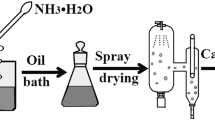Abstract
Copper oxide has attracted much attention in the field of anode materials for lithium-ion batteries because of its high capacity. However, in the long-term cyclic charge and discharge, due to the volume change, the electrode material is powdered, resulting in the rapid attenuation of capacity. In this paper, reduced graphene oxide is added to alleviate the volume problem of copper oxide charge and discharge, increase the contact area between active material and electrolyte, and finally improve the electrochemical performance of the material. Coated Copper oxide/reduced graphene oxide composites are synthesized by a one-pot method as anode materials for lithium-ion batteries. Herein, the morphology of the composite and the interface relationship in the reaction process have been systematically studied, and the relationship between the electrochemical properties of the composite and the composition ratio of the sample has been analyzed. The results indicate that the cycle capacity of the material increased first and then decreased with the increase of copper acetate content. When the content of copper acetate is 100 mg/140 ml, the cycle capacity reaches the highest and its value reaches 504 mAh g−1. This result is circulated for 100 times at 200 mA g−1 current density.








Similar content being viewed by others
Data availability
All data generated or analyzed during this study are included in this published article and its supplementary information files.
References
Z. Zhou, A. Kyritsakis, Z. Wang et al., Effect of the anode material on the evolution of the vacuum breakdown process. J. Phys. D 54(3), 035201 (2021)
D. Su, H.J. Ahn, G. Wang, SnO2@graphene nanocomposites as anode materials for Na-ion batteries with superior electrochemical performance. Chem. Commun. 49(30), 3131 (2013)
A. Nahrawy, A. Hammad, A.M. Youssef et al., Thermal, dielectric and antimicrobial properties of polystyrene-assisted/ITO: Cu nanocomposites. Appl. Phy. A 125(1), 46.1-46.9 (2019)
H. Zhang, A highly electroactive poly(aniline-co-thionine) for rechargeable zinc batteries. J. Electrochem. Soc. 168(6), 060526 (2021)
Y. Zhang, L. Fang, W. Sun et al., A novel synthesis of Nb2O5@rGO nanocomposite as anode material for superior sodium storage. Chin. Chem. Lett. 32(3), 1144–1148 (2020)
K.N. Manukumar, B. Kishore, R. Viswanatha et al., Ta2O5 nanoparticles as an anode material for lithium ion battery. J. Solid State Electrochem. 24(24), 1–8 (2020)
R. Dang, X. Jia, P. Wang et al., Hydrothermal synthesis of peony-like CuO micro/nanostructures for high-performance lithium-ion battery anodes. Chin. Chem. Lett. (2017). https://doi.org/10.1016/j.cclet.2017.09.064
R. Wu, X. Qian, F. Yu et al., MOF-templated formation of porous CuO hollow octahedra for lithium-ion battery anode materials. J. Mater. Chem. A 1(37), 11126–11129 (2013)
K.-H. Li, C.-L. Kuo, Lithiation mechanisms and lithium storage capacity of reduced graphene oxide nanoribbons: a first-principles study. Mater. Chem. A 5, 4912–4922 (2017)
A. Da, L. Meng, C. Mh et al., Design of a 1D/2D C3N4/rGO composite as an anode material for stable and effective potassium storage—ScienceDirect. Energy Storage Mater. 25, 495–501 (2020)
J. Sun, M. Li, S. Oh et al., Recent advances of bismuth based anode materials for sodium-ion batteries. Mater. Technol. 33(8), 563–573 (2018)
D. Saritha, A concise review on the advancement of anode materials for Li-ion batteries. Mater. Today: Proc. 19(30), 726–730 (2019)
S.L. Kuo, W.R. Liu, C.P. Kuo et al., Lithium storage in reduced graphene oxides. J. Power Sources 244, 552–556 (2013)
J. Yang, F. Zhao, B. Zeng, One-step synthesis of a copper-based metal–organic framework–graphene nanocomposite with enhanced electrocatalytic activity. Rsc Adv. 5(28), 22060–22065 (2015)
D.S. Kim, G.H. Lee et al., Electrocatalytic performance of CuO/grapheme nanocomposites for LiO2 batteries. J. Alloys Compd. 707, 275–280 (2017)
K.O. Ogunniran, G. Murugadoss, R. Thangamuthu et al., Nanostructured CeO2/FeO3/Mn-rGO composite as anode material in Li-ion battery. J. Alloys Compd. 786, 873–883 (2019)
J.N. Tiwari, R.N. Tiwari, K.S. Kim, Zero-dimensional, one-dimensional, two-dimensional and three-dimensional nanostructured materials for advanced electrochemical energy devices. Prog. Mater. Sci. 57, 724–803 (2012)
Y. Shi, G. Chen et al., Effective regeneration of LiCoO2 from spent lithium-ion batteries: a direct approach towards high-performance active particles. Green Chem. (2018). https://doi.org/10.1039/C7GC02831H
Funding
This study was funded by the National College Student Innovation and Entrepreneurship Training Program (Grant No. 202010407013) and the Natural Science Foundation of Jiangxi Province (Grant No. 20192BAB206002).
Author information
Authors and Affiliations
Contributions
YL and ZJ contributed to the conception of the study. ZJ and HY performed the experiment. ZJ, YL, and XZ contributed significantly to analysis and manuscript preparation. YW helped to perform the analysis with constructive discussions.
Corresponding author
Ethics declarations
Conflict of interest
The authors have not disclosed any competing interests.
Research involving human and animal participants
This article does not contain any studies with human participants or animals performed by any of the authors. In this experiment, we did not collect any samples of human and animals.
Additional information
Publisher's Note
Springer Nature remains neutral with regard to jurisdictional claims in published maps and institutional affiliations.
Rights and permissions
About this article
Cite this article
Jiang, Z., Yu, H., Zhou, X. et al. Copper oxide/reduced graphene oxide composites for improving long-term cyclic charge and discharge of high-capacity lithium-ion batteries. J Mater Sci: Mater Electron 33, 16297–16305 (2022). https://doi.org/10.1007/s10854-022-08522-0
Received:
Accepted:
Published:
Issue Date:
DOI: https://doi.org/10.1007/s10854-022-08522-0




